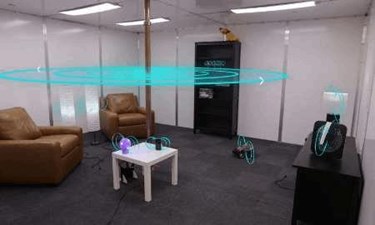Disney Researchers Devise Room-Scale Wireless Power Charging Method
By Jof Enriquez,
Follow me on Twitter @jofenriq

Scientists at Disney Research have demonstrated a new method of charging devices wirelessly across a room bathed in magnetic fields emanating from metalized walls, floor, and ceiling. This new technique makes it possible for any living room, office, or warehouse to deliver safe and ubiquitous wireless power to devices contained anywhere within.
The Disney researchers were inspired by Nikola Tesla, who had the idea of sending wireless power through electromagnetic waves that travel around the world. Today, most wireless power transmission occurs across much shorter distances, with the best known technique being near-field coupling involving charging stands, mats, or pads used to charge smartphones and other wireless devices. Other recent research work has extended the distance to at least 0.5 meters, 5 meters, and as far as 50 meters away from the power source.
Disney Research scientists say they want to realize the potential for wireless power charging as easily as data as transmitted through the air – a la WiFi hotspots – where you can just walk into an office or room to get an Internet reception.
"We introduce quasistatic cavity resonance (QSCR), which can enable purpose-built structures, such as cabinets, rooms, and warehouses, to generate quasistatic magnetic fields that safely deliver kilowatts of power to mobile receivers contained nearly anywhere within," they wrote in the journal PLOS ONE.
To demonstrate how QSCR works, the researchers built a metallic room with dimensions of 16 x 16 x 7.5 feet, with the floor, ceiling, and walls made of painted aluminum sheet metal. At the center of the room was placed a central copper pole with a diameter of 7.2 cm. Inserted across a 2.5-cm gap in the pole are 15 high-Q discrete capacitors totaling 7.3 pF, producing resonance at 1.32 MHz, and isolating potentially harmful electrical fields.
"It is those capacitors that set the electromagnetic frequency of the structure and confine the electric fields," said researcher Matthew J. Chabalko in a news release.
In order to measure wireless power transfer (WPT) efficiency, a 6-turn, 16.5 cm wide, square coil receiver is used, and a 28 cm, 8-turn, spiral drive coil is used to stimulate the room.
The researchers then furnished the room with standard bookshelves, chairs, and tables to demonstrate a key benefit of using magnetic fields in the low megahertz frequency range: they do not interact with common, everyday materials.
The experiment was proven successful when ten electronic devices, augmented with wireless power receivers, were successfully powered when the signal generator, power amplifier, and drive coil were used to inject 15 watts of RF power into the room.
"Our simulations show we can transmit 1.9 kilowatts of power while meeting federal safety guidelines," Chabalko said. "This is equivalent to simultaneously charging 320 smart phones."
The researchers believe that the use of modular panels, retrofitting, or conductive paint will eliminate the need for completely metalized rooms to achieve the same results.
"QCSR based wireless power offers a viable method for eliminating the wires and batteries that have limited many innovative solutions in the industrial, medical, and consumer electronic spaces while providing an unprecedented amount of spatial charging freedom," they concluded.
